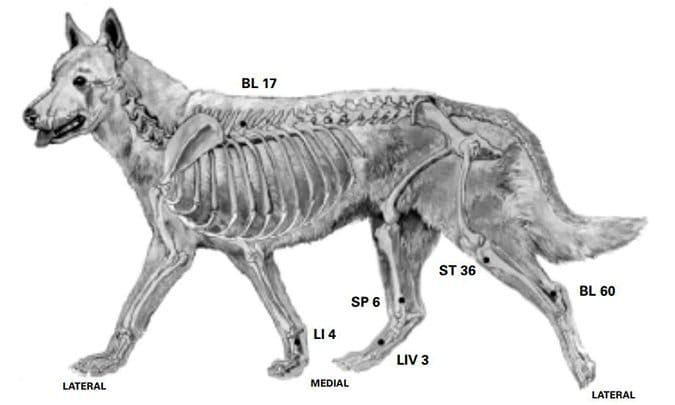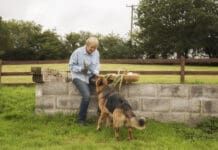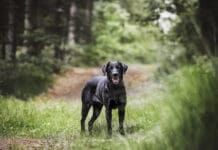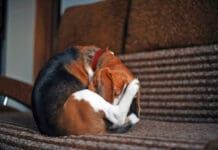[Updated February 8, 2018]
During the past decade, conventional veterinary surgery has made great strides in helping dogs lead more comfortable and fuller lives. But an ancient therapy – acupressure – nicely augments the more modern medical practice and increases its benefits.
Oak, a Golden Retriever puppy, is a good example of how one of the newer surgical procedures benefited and extended his life, and how acupressure improved the surgery’s effectiveness.

As in many service dog breeding programs, Oak was bred for one particular trait: his temperament. In this case, Oak and his Golden Retriever littermates were bred to be calm, easygoing, highly social, and trainable. When breeding for a single trait, often the health of an animal is compromised in other ways. Unfortunately, every puppy in the litter had orthopedic problems and none were able to fulfill their intended mission of being a service dog.
By the time Oak was 10 months old, it was clear that he had severe hip dysplasia. Radiographs confirmed that there was literally no hip socket on his right side.
After consulting with three veterinary surgeons, it was decided that the best course of action was a triple pelvic osteotomy (TPO), where the hip is reformed to create a socket. This procedure was considered experimental 10 years ago when Oak was much in need of it. Today, it is a common surgery for hip dysplasia.
Traditional Chinese Medicine for Post-Op Healing
Immediately following the surgical procedure, Oak received an acupressure session specifically for post-operative issues to support him in his recovery. Acupressure, like acupuncture, is based on Traditional Chinese Medicine (TCM). The intent of Oak’s acupressure sessions was to bring more chi (pronounced “chee” and also seen as Qi or Ki), the life-promoting energy that the ancient Chinese saw as essential for all life; and increase “Blood” flow, to optimize the healing process while maintaining the body’s energetic balance.
In TCM, “Blood” is not only the nutrient-rich, red fluid that flows through our veins; it is more broadly defined as fluids that nourish and moisten the body’s organs, bones, and other tissues.
Tallgrass Animal Acupressure Institute

According to TCM, there are energetic pathways (called meridians) where chi and Blood flow through the canine body. Along these meridians there are specific points, or acupoints, where we can apply pressure and actually influence the flow of chi, Blood, and other body fluids. When there is an interruption or blockage of chi along the meridian, acupoints are used to restore the natural harmonious flow of chi and Blood so that the body can heal itself.
From a Chinese Medicine perspective, any surgical procedure represents an insult or injury to the body that disrupts the flow of chi and Blood. To support the animal’s healing process, we select acupoints that can:
• Help with pain management;
• Clear the effects of anesthesia;
• Minimize the building of scar tissue;
• Reduce swelling and collection of body fluids; and,
• Enhance the circulation of chi and Blood to ensure the removal of toxins and provide nourishment to the injured area.
Canine Acupressure Points for Post-Surgical Healing
Tallgrass Animal Acupressure Institute

| POINT | FUNCTION & LOCATION |
| BL 17 | Improves Blood and chi circulation. Lateral to the caudal border of the spinous process of the 7th thoracic vertebrae. |
| BL 60 | “Aspirin Point” relieves pain in the body. Located at the thinnest part of the hock, lateral aspect. |
| LI 14 | Relieves pain, promotes circulation of protective chi and Blood. Benefits the immune system. Located at webbing of dewclaw. |
| ST 36 | Promotes chi and Blood flow and benefits the immune system. Located just lateral to the tibial crest. |
| SP 6 | Promotes Blood and chi circulation. Located about three inches above the tip of the medial malleolus. |
| LIV 3 | Helps remove toxins, regulates and tonifies Liver Blood. Found between the 1st and 2nd metatarsal bones. |
Recovering from the Triple Pelvic Osteotomy
Oak’s acupressure sessions began within an hour after surgery, while he was still under the influence of the anesthesia. For the first four days, he received a session every 24 hours. For the following two weeks he had an acupressure session every third day.
A week after his extensive TPO surgery, Oak went back to the surgeon for a check-up. As he walked down the hall and into the examination room, the surgeon, while watching him walk asked, “Is Oak here for his month check? He is walking very well.”
Within a week, Oak had gone from being in extreme pain and almost completely immobilized to being able to walk comfortably and evenly on both flat terrain and up and down stairs. Thanks to his basic good health and acupressure sessions, Oak’s rapid recovery took the surgeon by surprise.
Because of the advancements in conventional medicine and the powerful healing capacity of TCM, Oak, now 10 years old, is still able to jump into the back of an SUV, run up and down hills, play with buddies, and swim in ponds.
My Golden Retriever’s Acupressure Session
Start by finding a comfortable location for both you and your dog. Take a few even breaths in and out while thinking about how you want to help your dog.
Rest one hand on the dog’s shoulder. Using the heel of your other hand, place it at the top of his head and gently stroke down his neck, just off the midline. (For smaller dogs, use your index and second fingers to stroke down the dogs neck.) Staying just to the side of the dog’s spine, continue to trace the path of the Bladder Meridian (see illustration, next page), going toward his tail and over his rump, then down the outside of his hind leg to the tip of his outside toe.
Repeat this intentional stroking procedure three times on each side of the dog following the Bladder Meridian. In the illustration (right), note that the meridian is located on both sides of the spine, so you should work on both sides of the dog.
Begin working on the points by resting one hand on your dog wherever it feels comfortable; this is your anchor hand. You can move it whenever you need to for comfort. You can use either the thumb or two-finger technique to perform the point work, depending on which is more comfortable for you and your dog.
• Thumb technique: Place the fleshy tip of your thumb directly on the acupressure point at a 90-degree angle and hold the point gently but with intent. Count to 30 before moving to the next acupoint.
• Two-finger technique: Put your middle finger on top of your index finger and then place your index finger at approximately a 90-degree angle to the point. Gently, but with intentional firmness, apply pressure directly on the acupoint and count to 30; then move to the next acupoint. The two-finger technique tends to work best for smaller animals and in places where it is difficult to reach.
Once you have finished stimulating the acupressure points on one side of your dog, be sure to hold the points on the other side. Doing both sides will ensure a balanced and more complete treatment.
Observe your dog’s reaction to the work on the points. “Energy releases” mean your session is working. Healthy energy releases include yawning, deep breathing, muscle twitches, release of air, deeper relaxation, licking, and softening of the eye. If your dog is overly reactive to a particular point or exhibits a pain reaction, skip it, and try that point again at a later session.
Complete your acupressure session by resting your hand comfortably on your dog’s shoulder just the way you did when starting the treatment. Place the heel of your other hand, or index and middle fingers, just off the midline of the top of his head and stoke down the Bladder Meridian: down his neck, over his back to his hindquarters, keeping your hand to the side of his spine, and down the outside of his leg to his outer toe. Your opposite hand can lightly trail along the same path as the working hand.
Repeat this procedure three times on each side of your dog. It can take 24 hours for the effects of an acupressure treatment to be fully experienced.
Amy Snow and Nancy Zidonis are the authors of The Well-Connected Dog: A Guide to Canine Acupressure, Acu-Cat: A Guide to Feline Acupressure, and Equine Acupressure: A Working Manual. They founded Tallgrass Animal Acupressure Institute, which offers a practitioner certificate program and training programs worldwide, plus books, meridian charts, and videos.






